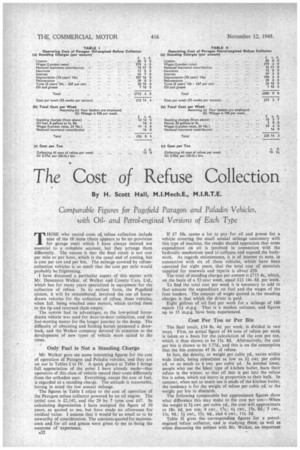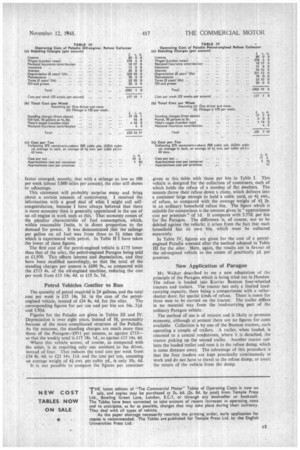The Cost of Refuse Collection
Page 34

Page 39

If you've noticed an error in this article please click here to report it so we can fix it.
By H. Scott Hall, M.I.Mech.E., M.1.R.T.E.
Comparable Figures for Pagefield Paragon and Paladin Vehicles, with Oiland Petrol-engined Versions of Each Type
THOSE who recOrd costs ok refuse collection include nine of the 10 items (there appears to be no provision for garage rent) which I have always insisted are essential to a complete account, but they arrange them differently. The reason is that the final result is not cost ' per mile or per hour, which is the usual end of costing, but is cost per ton and per bin. The mileage covered by refusecollection vehicles is so small that the cost per mile would probably be frightening.
I have discussed a particular aspect of this matter with Mr. Densmore Walker, of Walker and County Cars, Ltd., which has for many years specialized in equipment for the collection of refuse. In its earliest form, the Pagefield system, it will be remembered, involved the use of horsedrawn vehicles for the collection of refuse, these vehicles, when full, being winched onto motors, which carried them to the tip and returned them empty.
The system had its advantages, as the low-priced horsedrawn vehicle was used for door-to-door collection, and the fast-moving motor for the longer journey to the dump. The difficulty of obtaining and feeding horses presented a drawback, and the Walker company devoted its attention to the development of new types of vehicle more suited to the times. .
Only Fuel is Not a Standing Charge
• Mr. Walker gave me some interesting figures for the cost of operation of Paragon and Paladin vehicles, and they are set out in Tables I to IV. A quick glance at Table 1 brings full appreciation of the point I have already made—that operators of this class of vehicle record their costs differently from the orthodox user. Everything, except the cost of fuel, is regarded al, a standing charge. The attitude is reasonable, having in mind the low annual mileage.
The figures in Table I relate to the cost of operation of the Paragon refuse collector powered.by an oil engine. The initial cost is 12,145, and the 29 by 7 tyres cost 167. In calculating depreciation I have accepted the figure of 10 years, as quoted to me, but have made no allowance for residual value. I assume that it would be so small as to be unworthy of consideration. The amounts quoted for maintenance and for oil and grease were given to me as being the outcome of experience.
A32 If £7 10s. seems a lot to pay for oil and grease for a vehicle covering the small annual mileage customary with this type of machine, the reader should appreciate that some expenditure on oil is involved in connection with the hydraulic mechanism used to collapse and expand the bodywork. As regards maintenance, it is Of interest to note, in connection with six of these vehicles, which have been operated for eight years, that the total cost of materials supplied for renewals and repairs is about £20. The total of standing charges per annum is £713 4s., which, on the basis of a 52-year week, equal £13 14s. 4d. per week.
To find the total cost per week it is necessary to add to that amount the expenditure on fuel and the wages of the four loaders. The amount of wages quoted in the standing charges is that which the driver is paid. . Eight gallons of oil fuel per week for a mileage of 100 equals 121 m,p.g. That is a modest estimate, and figures up to 15 m.p.g. have been experienced.
Cost Per Ton or Per Bin
The final result, £34 Ss. 4d. per week, is divided in two ways. First, an actual figure of 44 tons of refuse per week is taken as a basis for the calculation of the cost per ton, which is thus shown to be 15s: 8d. Alternatively,' the cost per bin is shown to be 3.77d., and this is on the assumption that the bin contains 45 lb. of refuse.
In fact, the density, or weight per cubic yd., varies within wide limits, being sometimes as low as 31 cwt, per cubic yd. or as much as 6 cwt. per cubic yd. In normal times, people who use the Ideal type of kitchen boiler, burn their refuse in the winter, so that all that is put into the refuse bin is ashes, which are heavy in proportion to their bulk. In summer, when not so much use is made of the kitchen boiler, the tendency is for the weight of refuse per cubic yd. 'or the weight per bin to diminish. The following comparable but approximate figures show what difference this may make to the cost per ton:—When the weight is 31 cwt. per cubic yd., the cost will approximate to 18s. 6d. per ton; 4 cwt., 17s.; 41 cwt., 15s. 8d.; 5 cwt., 13s. 9d.; 51 cwt., 12s. 6d., and 6 cwt., lls. 3d.
Table II gives the corresponding figures for a petrolengined refuse collector, and in studying these, as well as when discussing the subject with Mr. Walker, an important
factor emerged, namely, that with a mileage as low as 100 per week (about 5,000 miles per annum), the oiler still shows to advantage.
This statement will probably surprise many and bring about a certain amount of controversy. I received the information with a good deal of what I might call selfcongratulation, because I have always believed that there is more economy than is generally appreciated in the use of an oil engine in work such as this. That economy comes of the peculiar characteristic of fuel consumption, which, within reasonable limits, is in direct proportion to the demand for power. It was demonstrated that the mileage per gallon on oil fuel was from three to 3k tithes that which is experienced with petrol. In Table WI have taken the lower of these figures.
The first cost of the petrol-engined vehicle is £175 lower than that of the oiler, the petrol-engined Paragon being sold at £1,970. This affects interest and depreciation, and they have been modified accordingly, so that the total of the standing charges per annum is £690 9s., as compared with the £713 4s. of the oil-engined machine, reducing the cost per week from £13 14s. 4d. to £13 5s. 7d.
Petrol Vehicles Costlier to Run
The quantity of petrol required is 24 gallons, and the total cost per week is £35 14s. 3d. in the case of the petrol engined vehicle, instead of £34 8s. 4d. for the oiler. The corresponding figures for per ton and per bin are 16s. 341. and 3.93d.
Figures for the Paladin are given in Tables III and IV: Depreciation is over eight years, instead of 10, presumably because of the more complicated structure of the Paladin. As the outcome, the standing charges are much more than those of the Paragon—£931 per annum, as against £713— so that the weekly total is £17 18s. Id., as against £13 14s. 4d.
Where this vehicle scores, of course, as compared with the other, is in requiring only one assistant to the driver, instead of four. That reduces the total cost per week from £34 8s. 4d. to £23 145. Ild. and the cost per ton, assuming an average weight of 4/ cwt. per cubic yd., 4s only 10s. 6d.
It is not possible to compare the figures per container given in this table with those per bin in Table I. This vehicle is designed for the collection of containers, each of which holds the refuse of a number of flat dwellers. The tenants throw their refuse down a chute, which delivers into a container' large enough to hold a cubic yard, or 4/ cwt., of refuse, as compared with the average weight of 4i lb. in an ordinary household refuse bin. The figure which is suitable for comparison is the amount given in "approximate cost per premises" of Id. It compares with 3.77d. per bin for the Paragon. The difference is, of course, not to be debited against the vehicle; it arises from the fact that each household has its own bin, which must be collected separately.
In Table IV, figures are given for the cost of a petrolengined Paladin assessed after the method adopted in Table III for the oiler. Here, again, the results are in favour of the oil-engined vehicle to the extent of practically Id. per premises.
, New Application of Paragon
Mr. Walker described to me a new adaptation of the principle of the Paragon which is being tried out in Hendon. The refuse is loaded into Karrier Bantam four-wheeled tractors and trailers. The tractor has only a limited loadcarrying capacity, there being a compartment with a rollershutter door, for special kinds of refuse. There is room for three men to be carried on the tractor. The trailer differs in no material way from the load-carrying part of the ordinary Paragon vehicle.
The method of use is of interest and is likely to promote economy, although at present there are no figures for costs available. Collection is by one of the Bantam tractors, each operating a couple of trailers. A trailer, when loaded, is returned to a central rendezvous, where it is detached, the tractor picking up the second trailer. Another tractor collects the loaded trailer and runs it to the refuse dump, which is some distance away. The advantage of this procedure is that the four loaders are kept practically continuously at work and do not have to travel to the refuse dump, or await the return of the vehicle from the dump.




























































































